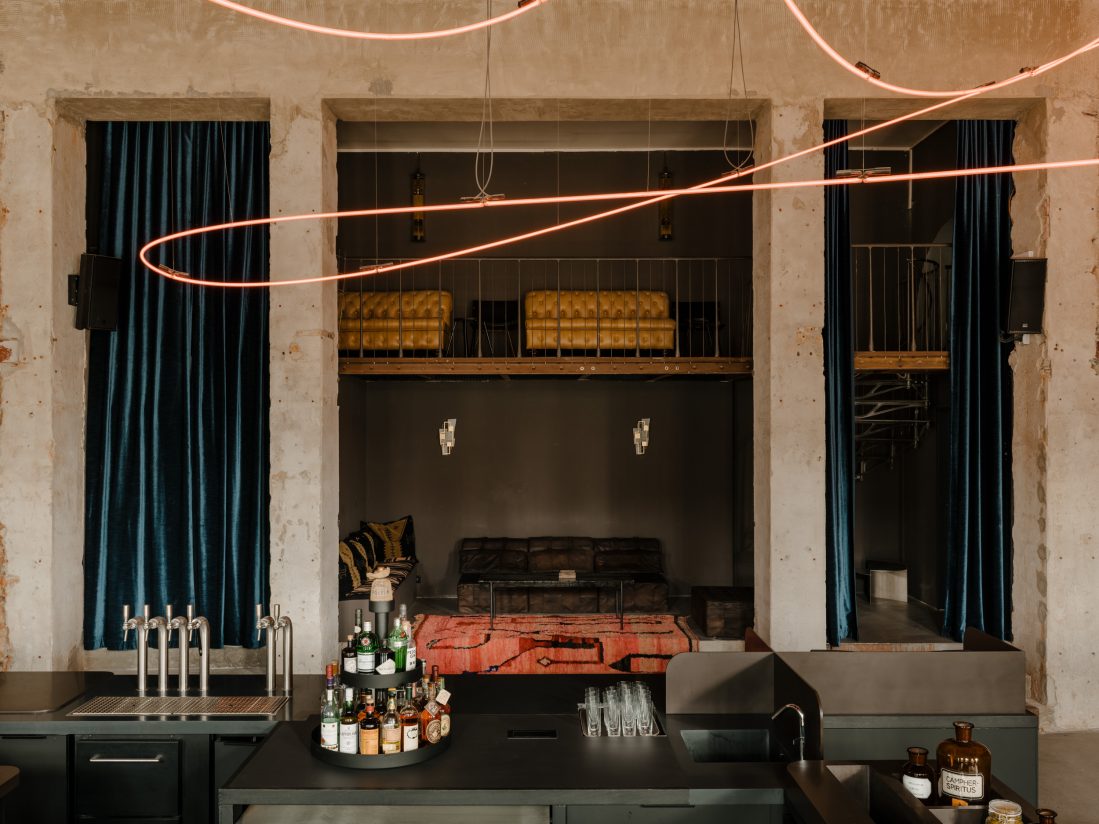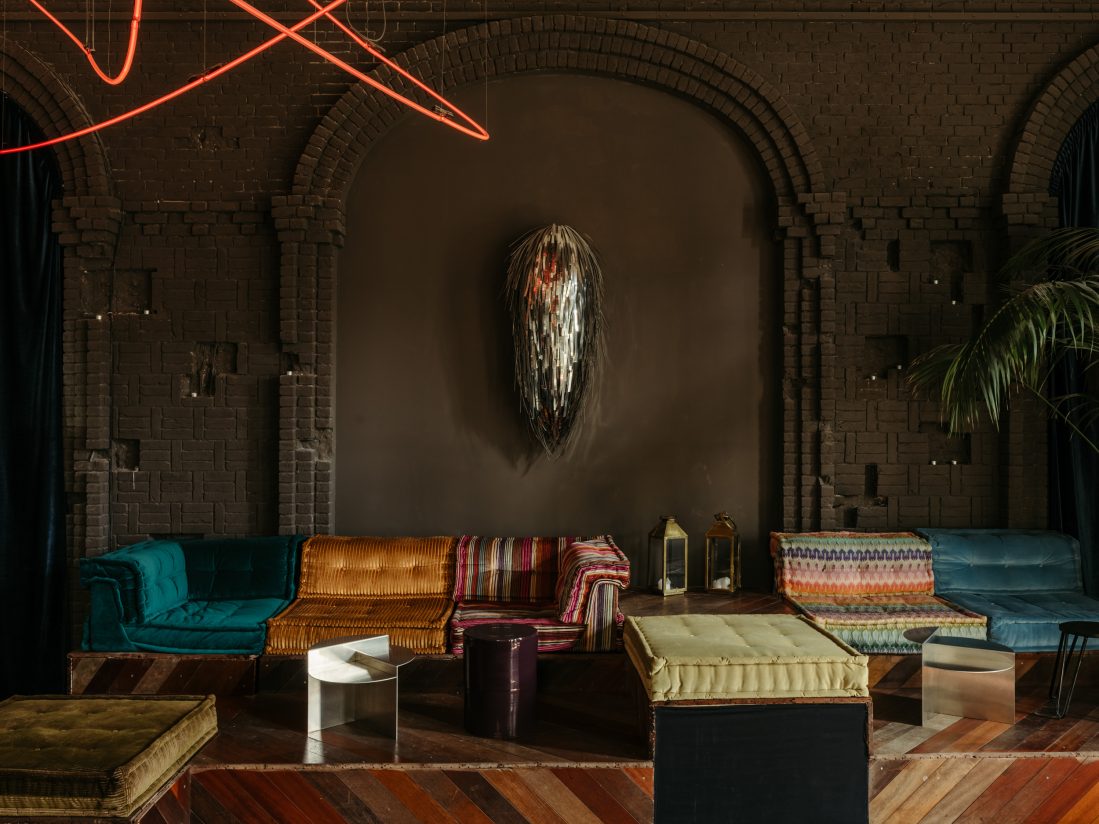In Constant Dialogue with Art, Design and Gastronomy
Kink Bar & Restaurant opened recently in a restored industrial building located in the heart of Prenzlauer Berg’s multidisciplinary cultural venue Pfefferberg in Berlin with interiors that put the focus on art and experiences in eclectic spaces that make the visitor experience multifaceted.
With everything we do we ask ourselves if it got KINK? Does it entice senses? Does it break boundaries?”
Oliver Mansaray and Daniel Scheppan
Founders of KINK
KINK Bar & Restaurant is nestled in the sociocultural center Pfefferberg, which is host to various galleries, artist studios and event venues. Building on its vast adaptive space and eight-meter-high ceiling, KINK brings together contemporary art, modular design and world gastronomy, to offer a both multifaceted and deeply personal visitor experience. KINK acts as a sociocultural space for healing, reconstruction, and discovery – its very name embodying a combination of bliss, “and a touch of nonsense,” as described by the founders, Oliver Mansaray and Daniel Scheppan.
“The central theme behind KINK is to tear down walls, be brave to try new things and never be ok with something only because it was always like that. With everything we do we ask ourselves if it got KINK? Does it entice senses? Does it break boundaries?” say the founders Oliver Mansaray and Daniel Scheppan about their experimental and synergetic approach to KINKS eclectic interiors.
Sustaining a constant dialogue with art and design, the wide room inside is reinvested through a selection of contemporary installations and works presented throughout the restaurant and bar. At its core, suspended from its high ceiling, Swiss contemporary artist Kerim Seiler’s Spaceknot– a large-scale site-specific work consisting of over 100 meters of red neon tubes – elegantly loops through the space. Rethinking the void “as his canvas,” the artist transforms what appears to be a two-dimensional twisted knot into a multi-dimensional space-embracing sculpture. The contrasting glow of its interconnected segments plays with the architectural scale of the room, thereby creating an all-inclusive immersive atmosphere.
“The Spaceknot can be read in many ways – both conceptually and figuratively. It is at once an abstract ‘doodle’ in space and the flight path of a bumble-bee’s roly-poly made visible. The lightness of this seemingly enormous installation, evocative of a spontaneous gesture, brings attention to an otherwise void headspace and enriches it with what becomes a point of reference for the entire space. Set at its core, it becomes its very essence – an object of meditation,” explain the founders and designrs of the space.
The idea behind the interior is to work with contrast of materials and qualities, they say. “For example, the rough uncovered brick wall next the central bar that looks like a space ship. The bar space should feel warm, comfortable and welcoming but still impressive without being pretentious. Most of all we go through the location and ask ourselves if every seat could be someone’s favorite space – if the answer is no, we’re not done yet.”
In constant conversation with the work, the post-industrial atemporal setting combines classic and vintage elements with contemporary design features and objects. Separated into three spaces – a vast main room, a gallery and a window-enveloped “Glashaus” – the different levels allow for distinct functions and ambiances. The vast room fans out from its focal point, the central open kitchen and bar designed by Berlin studio Hidden Fortress combined with sitting areas as a single overlapping, merged space for staff and visitors alike.
Deploying the height of the room, the side mezzanine looks out onto the lower floor, revealing German artist Philipp Emanuel Eyrich’s wall-embracing metalwork, in dialogue with Berberlin handcrafted rugs, inspired by North African Berber culture, and a set of Roche Bobois signature modular Mah Jong sofas. Upon entering from the surrounding beer garden – Berlin’s second oldest dating from 1850 – and through the 19th-century French wing doors, the resulting space breaks from the rules of formal spatial disposition, taking down barriers and encouraging visitors’ experimentation with – and experience within – the space.
An affirmation of founders Oliver and Daniel’s experimental and synergetic approach, the in-house laboratory – nested in the wall and projecting onto the bar– acts as an open workshop where modern techniques and culinary expertise and experience come together.
Sharing a longstanding passion for the discovery and fusion of international food and drinking cultures, Oliver and Daniel built on their respective careers in engineering and design to launch KINK in 2019. They explain: “We bring together what belongs together: kitchen and bar. Not only do we create a unique space where restaurant and bar see eye-to-eye, we unite culinary and cocktail art into one cohesive experience.” Drawn to – and drawing from – the cultural ambition of Pfefferberg, they highlight the importance of art and design as part of the space: “We cherish art that interrogates, moves and stimulates exchange. Art reveals differences – and similarities.”
 Located in a former mid-19th century brewery, Pfefferberg was founded in 1990 as an initiative from local residents, bringing together social, cultural and commercial activities – the latest addition being KINK, hosting a year-long programme of concerts, dance and theatre performances and a variety of multidisciplinary events. Reinvesting the decaying site, Pfefferberg’s, and KINK’s, vision is deeply related to the immediate vicinity of Prenzlauer Berg, an area of the city long divided by the Berlin wall, where lingering sentiments of segregation and displacement are reflected in the urban structure and architectural landscape.
Located in a former mid-19th century brewery, Pfefferberg was founded in 1990 as an initiative from local residents, bringing together social, cultural and commercial activities – the latest addition being KINK, hosting a year-long programme of concerts, dance and theatre performances and a variety of multidisciplinary events. Reinvesting the decaying site, Pfefferberg’s, and KINK’s, vision is deeply related to the immediate vicinity of Prenzlauer Berg, an area of the city long divided by the Berlin wall, where lingering sentiments of segregation and displacement are reflected in the urban structure and architectural landscape.


















